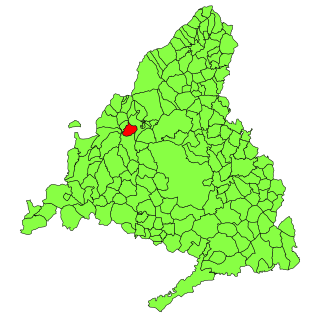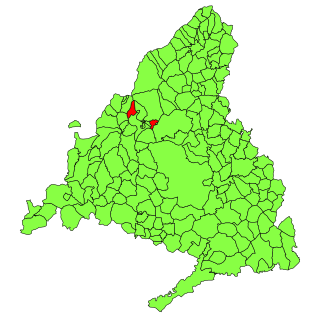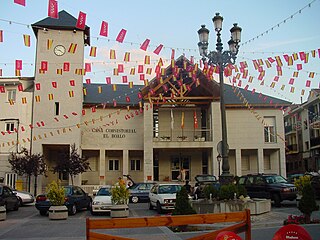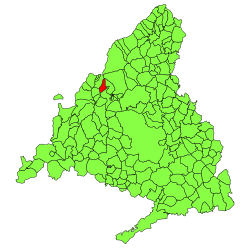
Las Rozas de Madrid is a municipality in the autonomous community of Madrid, Spain, with an area of 59 km² .
Soto del Real, whose former name was Chozas de la Sierra, is a town and municipality in the northern area of the autonomous Community of Madrid which had 9,188 inhabitants in 2022.

Collado Villalba is a municipality of the Community of Madrid, in central Spain. It is located 40.3 kilometres north-west of the city of Madrid, at an altitude of 917 meters above sea level. It has a population of 64,263 (2022), with a population density of about 2,400 per km2. Collado Villalba has a hot summer Mediterranean climate.

The Autovía A-6 or Autopista AP-6 is a Spanish autovía and autopista route that starts in Madrid and ends in Arteixo.

The Autopista AP-6 (also called Autopista del Noroeste or Carretera de La Coruña is a part of the Spanish A-6 Autopista del Noroeste starting at Las Rozas de Madrid and finished at Adanero. Between Las Rozas and Collado Villalba, is a freeway. All of it is a Free/tollway or a Motorway. Las Rozas-Collado Villalba is not a Spanish "Autovía" autopista toll route which starts in Collado Villalba and ends in Adanero. The portion, between Las Rozas and Collado Villalba, forms part of it, but without toll. Madrid-Las Rozas, Adanero-Arteixo on the same route is a Spanish "autovía" not a free/tollway, motorway, either a two-lane road. "Autovia" is in the middle between both road types, but the crosses always are with bridges like in the motorways/toll/freeway.

Galapagar is a town and municipality northwest of Madrid, Spain, situated in the autonomous community of the Community of Madrid. Of all the towns in the area, it was experiencing the most growth, mostly because of immigration and the conversion of old livestock fields into terrain for construction.

Club Unión Collado Villalba is a Spanish football club based in Collado Villalba, in the autonomous community of Madrid. Founded in 1960, it plays in Tercera Federación – Group 7, holding home games at Ciudad Deportiva de Collado Villalba, which has a capacity of 1,000 spectators.

Club Deportivo Paracuellos MX S.A.D., formerly known as Paracuellos Antamira is a Spanish football club based in Paracuellos de Jarama, in the autonomous community of Madrid. Founded in 1995, it plays in Tercera Federación – Group 7, holding home games at Estadio Municipal, which has a capacity of 1,500 spectators.

Becerril de la Sierra is a municipality of the autonomous community of Madrid in central Spain.

Cercedilla is a municipality in the Community of Madrid, in central Spain. It is located in the Sierra de Guadarrama.

Navacerrada is a municipality of the Community of Madrid, Spain. It lies at an elevation of 1,203 metres (3,947 ft) on the Reservoir Navacerrada and the entry of "Valle de la Barranca" in the Sierra de Guadarrama.
The 1984–85 ACB season was the 2nd season of the ACB Primera División, the top Spanish professional basketball league. It started on 23 September 1984 with the first round of the regular season and ended on 1 May 1985 with the finals. In this season, the league introduced the new FIBA rules with the three-point field goal as the main change.
The 1988–89 ACB season was the 6th season of the Liga ACB, after changing its name. The number of teams increased from 16 to 24. The format also changed. The 24 teams were divided into two groups of 12. After playing a league, 24 teams were divided into three groups of eight teams each. The first six of the white group and the champions of the red and blue groups played for the title.

El Boalo is a Spanish village of around 8200 inhabitants, 52 km (32 mi) northwest of Madrid, in the Community of Madrid.
Club Baloncesto Collado Villalba was a professional basketball club based in Collado Villalba, Spain.

Moncloa is a multimodal station in Madrid, Spain that serves Madrid Metro Line 3 and Line 6, as well as city buses and intercity and long-distance coaches. It is located underneath the Plaza De Moncloa and Calle de la Princesa near Arco de la Victoria and the headquarters of the Spanish Air and Space Force in fare Zone A.
Pedro Astray López is a Spanish footballer who plays as a central midfielder for Zamora CF.

Los Negrales is a residential zone in the municipal area of Collado Villalba, Alpedrete, San Lorenzo de El Escorial, Guadarrama and Galapagar, consisting mostly of detached houses. Although it was divided in three administrative zones, Los Negrales is a contiguous residential area. This residential zone was built gradually. The oldest houses date to the first half of the 20th century, and building has continued until contemporary times. A significant part of the houses are second residences of their owners, therefore, in summer and in holidays the population doubles.















